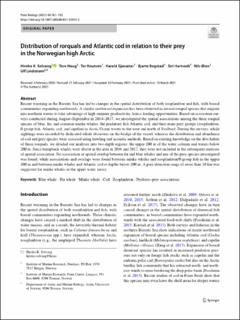| dc.description.abstract | Recent warming in the Barents Sea has led to changes in the spatial distribution of both zooplankton and fish, with boreal communities expanding northwards. A similar northward expansion has been observed in several rorqual species that migrate into northern waters to take advantage of high summer productivity, hence feeding opportunities. Based on ecosystem surveys conducted during August–September in 2014–2017, we investigated the spatial associations among the three rorqual species of blue, fin, and common minke whales, the predatory fish Atlantic cod, and their main prey groups (zooplankton, 0-group fish, Atlantic cod, and capelin) in Arctic Ocean waters to the west and north of Svalbard. During the surveys, whale sightings were recorded by dedicated whale observers on the bridge of the vessel, whereas the distribution and abundance of cod and prey species were assessed using trawling and acoustic methods. Based on existing knowledge on the dive habits of these rorquals, we divided our analyses into two depth regions: the upper 200 m of the water column and waters below 200 m. Since humpback whales were absent in the area in 2016 and 2017, they were not included in the subsequent analyses of spatial association. No association or spatial overlap between fin and blue whales and any of the prey species investigated was found, while associations and overlaps were found between minke whales and zooplankton/0-group fish in the upper 200 m and between minke whales and Atlantic cod at depths below 200 m. A prey detection range of more than 10 km was suggested for minke whales in the upper water layers. | en_US |
